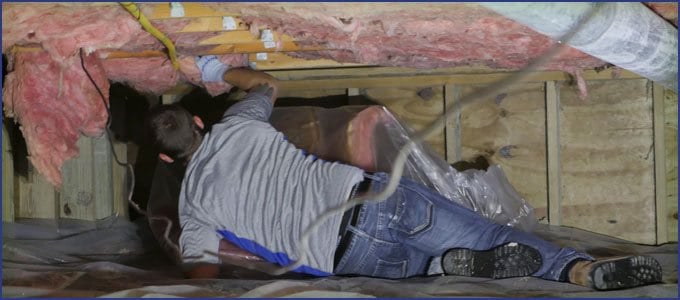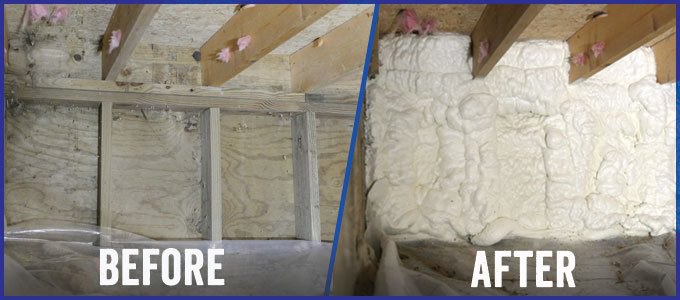Crawl Space Insulation Problems: Watch Out for These 6 Issues


Are socks and slippers a must-have in your home due to cold floors?
Little to no insulation in your crawl space can make your floors feel icy cold.
Just some of the problems associated with insulation problems in the crawl space include excess moisture, cold floors, and mold and rot issues.
RetroFoam of Michigan has insulated thousands of crawl spaces over more than 17 years. There’s not much we haven’t seen when it comes to the crawl space, but we have solutions that can make those problems go away.
Here is a look at the top six crawl space insulation problems and how you can fix them.
Crawl Space Insulation Problems

Using Insulation to Try to Solve Water Issues in the Crawl Space
Water can seep into the crawl space through poor circulation or from the foundation walls.
The excess moisture can lead to the growth of mold, as well as other issues like wood rot. Traditional insulation, like fiberglass, can act as a breeding ground for mold once it becomes wet.
Some homeowners believe using closed cell spray foam insulation will solve the leakage problem, but in actuality, it will only mask the issue and lead to bigger problems in the future.
Solution: First and foremost, you have to find out where the moisture is coming from. If the moisture is coming from poor circulation, then consider installing a plastic vapor barrier on the floor to keep it dry. Worst case scenario if the water is coming through the foundation walls, it will need to be repaired.
Mold on Insulation in Crawl Space
Fiberglass can work as a sponge when it comes to moisture seeping into the crawl space.
The moisture making its way into the crawl space will be absorbed by the fiberglass material, thus permanently reducing its R-Value and insulation capabilities. That moisture then has the potential to work its way up to the structural wood increasing the chance for mold growth and wood rot.
This mold growth can lead to serious health issues in your home.
Solution: Ensuring your insulation remains dry is the first option. Some homeowners have found that open cell spray foam insulation is also a good solution as it is moisture permeable and creates an air seal that will keep those floors warm and your home more comfortable.
Insulation Falling in Crawl Space Ceiling
Over time gravity can lead to fiberglass insulation under the house falling down from the ceiling of the crawl space open to cold air and making your floors colder.
Essentially when this happens you're left with no working insulation under the house.
Solution: If you have fiberglass you must check it regularly to make sure it isn’t sagging or falling from the crawl space roof. You can also consider a more permanent solution like open cell spray foam insulation for the crawl space ceiling or walls.
Frozen Pipes in the Crawl Space
Plumbing for your home can be found running throughout the crawl space.
If these pipes freeze and burst, then you will have moisture in the crawl space. This happens due to poor insulation and cold air leaking from the inside into the area.
Solution: Ensuring the pipes in the crawl space aren’t leaking should come first. Creating a vapor barrier and then insulating the crawl space with spray foam insulation can help to prevent pipes from freezing and bursting.
Floors Still Cold Even with Insulation
You assume your home is covered, but without an air seal, your floors are still cold.
Solution: Adding an air seal with traditional or spray foam insulation will make your floors warmer during the winter and help reduce monthly energy bills.
Insulation Not Applied Correctly
Whether it’s fiberglass or spray foam, if it isn’t applied correctly in the right area in the crawl space you will continue to have issues.
If there is ductwork in the crawl space and the insulation is installed on the ceiling, it won’t perform the way it should.
Solution: Ensure if there is ductwork in the crawl space that the walls are insulated and not the ceiling. If there is no mechanical in the crawl space, then it is appropriate to insulate the ceiling.
Fixing Your Crawl Space Insulation Problems
Understanding how the different kinds of insulation materials work could be the answer to your crawl space issues.
Some homeowners have found that a better long-term solution to fix their problems has been to remove the old insulation and replace it with spray foam insulation.
If you are interested in learning more about the benefits of foam insulation, check out our Learning Center.
Related Articles
Can You Spray Foam Insulation Over Mold?
Does My Dirt Floor Crawl Space Need a Vapor Barrier?
Will Spray Foam Keep Pipes From Freezing?
About Amanda Ringler
Amanda previously has worked as a breaking news and crime reporter, TV news producer, and editor in Flint and Detroit. Throughout her career as a journalist, she has won several awards from The Society of Professional Journalists - Detroit Chapter and the Michigan Press Association. As part of the RetroFoam of Michigan family, Amanda uses her experience as a journalist to write content that will help educate homeowners on the benefits of foam insulation. When Amanda isn’t writing, she’s spending time with her husband and rescued huskies. She also loves knitting, making art, cooking, and hosting dinner and a movie night for friends and family.

.jpg)
